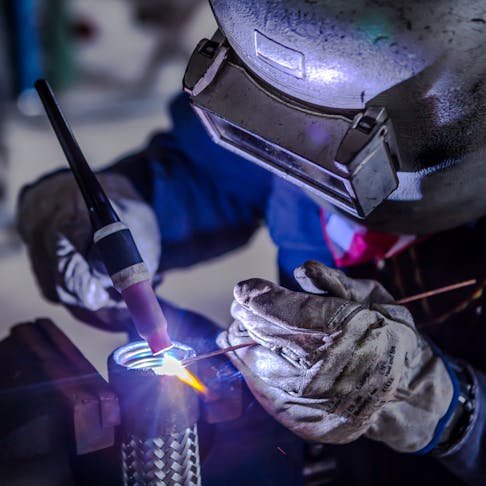Welding WPS Explained: Key Elements and Perks for Your Welding Processes
Wiki Article
The Ultimate Overview to Welding WPS Procedures: A Detailed Introduction for Welders
In the complex globe of welding, Welding Treatment Specs (WPS) serve as the backbone of guaranteeing quality, uniformity, and security in welding procedures (welding WPS). As we dig into the different parts of a WPS and explore the details of credentials and qualification, we will certainly discover the vital role these treatments play in the world of welding.Value of WPS Procedures
Comprehending the importance of Welding Treatment Specifications (WPS) treatments is critical for making certain the quality and stability of welded frameworks. WPS procedures function as a roadmap for welders, describing the needed actions, specifications, and products needed to achieve a sound weld. By adhering to WPS guidelines, welders can make certain consistency in their job, causing trustworthy and structurally sound welds.One of the main reasons why WPS procedures are necessary is their role in maintaining weld high quality and stability. Complying with the specified welding parameters and techniques laid out in the WPS aids prevent problems such as porosity, splitting, or insufficient fusion, which can compromise the toughness and sturdiness of the weld.

Parts of a WPS
A Welding Treatment Spec (WPS) typically consists of vital parts that detail the particular needs for executing a weld, making sure consistency and quality in the welding process. The crucial elements of a WPS consist of important variables such as base metals, filler steels, interpass and preheat temperature levels, welding procedures, securing gases, welding placements, and post-weld warmth therapy needs.Base steels refer to the materials being joined, while filler metals are made use of to load the gap in between the base steels during welding. Preheat and interpass temperatures are important for managing the warmth input and avoiding problems like cracking or distortion. The welding procedure describes the certain strategy to be made use of, whether it's gas metal arc welding (GMAW), secured steel arc welding (SMAW), or another technique. Protecting gases safeguard the weld swimming pool from climatic contamination. Welding settings specify the orientations in which welding can be performed. Post-weld warm treatment may be required to alleviate stress and anxieties and enhance the weld's residential properties. A comprehensive understanding of these components is vital for producing a thorough and reliable WPS.

Credentials and Certification
Having actually established the necessary components of a Welding Treatment Specification (WPS), the focus currently moves towards the crucial aspects of qualification and accreditation in welding practices.
Accreditation, on the other hand, is the official recognition of a welder's qualifications by a relevant accreditation body or organization. Welding qualifications are usually based upon the certain welding processes, materials, and settings a welder is certified to work with. Holding a legitimate welding site web certification shows that a welder satisfies market criteria and is proficient to do welding jobs to the called for specifications.
Producing a WPS
To develop a Welding Procedure Requirements (WPS) that fulfills industry standards, mindful consideration of welding procedures, products, and operational parameters is important (welding WPS). The initial action in creating a WPS is to determine the welding procedure to be utilized, such as gas steel arc welding (GMAW) or secured steel arc welding (SMAW) Once the welding procedure is identified, the following crucial facet is selecting the proper products, considering elements like base steel type, density, and joint layout. Operational criteria such as welding current, voltage, travel speed, and protecting gas composition should also be carefully defined in the WPS.
Applying and Keeping An Eye On WPS
Upon wrapping up the comprehensive Welding Treatment Spec (WPS) that diligently information welding procedures, materials, functional parameters, and quality control actions, the focus shifts to successfully applying and Get More Info checking the well established treatments. Execution entails guaranteeing that all welders associated with the task know with the WPS and follow it carefully throughout the welding procedure. This calls for supplying appropriate training and supervision to assure adherence to the defined treatments. Keeping an eye on the WPS includes constant oversight to verify that welding activities align with the recorded specifications. Assessments, testing, and quality assurance steps are vital parts of the tracking process to determine any concerns or variances immediately. Routine audits and testimonials of the welding procedures aid in preserving consistency and top quality throughout the task. Reliable application and monitoring of the WPS are crucial for guaranteeing the honesty, stamina, and security of the welded joints, eventually adding to the general success of the welding job.Final Thought
Finally, understanding and following Welding Treatment Requirements (WPS) is important for welders to ensure high quality, uniformity, and safety and security in their work. By understanding the components of a WPS, getting correct qualifications and certifications, creating detailed treatments, and applying and monitoring them successfully, welders can improve their abilities and effectiveness in welding practices. Sticking to WPS procedures is vital for generating premium welds and conference sector standards.
In the elaborate world of welding, Welding Treatment Specs (WPS) serve as the foundation of making certain quality, uniformity, and security in welding procedures. The welding procedure outlines the particular method to be utilized, whether it's gas steel arc welding (GMAW), shielded steel arc welding (SMAW), or an additional approach.To establish a Welding Treatment Requirements (WPS) that fulfills sector criteria, careful factor to consider of welding procedures, products, and functional parameters is vital. The very first action in producing a WPS is to identify the welding procedure to be used, such as gas steel arc welding (GMAW) or shielded metal arc welding (SMAW)Upon finalizing the extensive Welding Procedure Requirements (WPS) that diligently details welding processes, materials, operational parameters, and quality guarantee actions, the emphasis shifts to properly applying and keeping track of the well-known procedures.
Report this wiki page